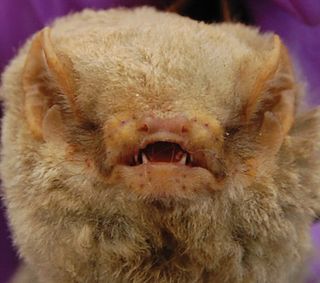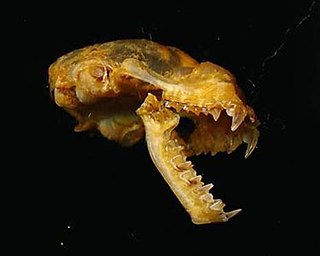
Beatrix's bat is a species of vesper bat in the family Vespertilionidae. It can be found in Angola, Central African Republic, Democratic Republic of the Congo, Ivory Coast, Equatorial Guinea, Gabon, Ghana, Kenya, and Nigeria. It is found in subtropical or tropical moist lowland forests.

The Abo bat is a species of vesper bat in the family Vespertilionidae. It is found in several countries in West Africa and Central Africa. It is found in subtropical and tropical dry and moist lowland forests.
Curry's bat is a species of vesper bat in the family Vespertilionidae. It is found in Cameroon and Democratic Republic of the Congo. Its natural habitats are subtropical and tropical moist lowland forests and subtropical and tropical swamps.

The lesser woolly bat is a species of vesper bat in the family Vespertilionidae. It is found in Botswana, Central African Republic, Democratic Republic of the Congo, Ivory Coast, Ethiopia, Gabon, Ghana, Guinea, Kenya, Liberia, Malawi, Nigeria, South Africa, Tanzania, Zambia, Zimbabwe and rarely Ethiopia. Its natural habitats are subtropical or tropical moist lowland forests, dry savanna, and moist savanna. Members of this species typically have a dark greyish brown fur with whitish tips scattered throughout.
Spurrell's woolly bat is a species of vesper bat in the family Vespertilionidae named after Herbert George Flaxman Spurrell. It is found in Cameroon, Democratic Republic of the Congo, Ivory Coast, Ghana, Guinea, Liberia, and Uganda. Its natural habitats are subtropical or tropical dry forests, subtropical or tropical moist lowland forests, and subtropical or tropical moist montane forests.
Smith's woolly bat is a species of vesper bat in the family Vespertilionidae. It is found in Cameroon, Democratic Republic of the Congo, Kenya, Nigeria, and Uganda. Its natural habitats are subtropical or tropical dry forests, subtropical or tropical moist lowland forests, subtropical or tropical swamps, and subtropical or tropical moist montane forests.
Thomas's rope squirrel or redless tree squirrel is a species of rodent in the family Sciuridae. It is found in Benin, Cameroon, Central African Republic, Democratic Republic of the Congo, Equatorial Guinea, Gabon, and Nigeria. Its natural habitat is subtropical or tropical moist lowland forests. It is a common species and the International Union for Conservation of Nature has rated it as being of "least concern".

The forest giant squirrel or Stanger's squirrel is a species of rodent in the family Sciuridae found in Angola, Benin, Burundi, Cameroon, the Central African Republic, the Republic of the Congo, the Democratic Republic of the Congo, Ivory Coast, Equatorial Guinea, Gabon, Ghana, Kenya, Liberia, Nigeria, Rwanda, Sierra Leone, Tanzania, Togo, and Uganda. Its natural habitats are subtropical or tropical moist lowland forests and plantations.

Fraser's musk shrew is a species of mammal in the family Soricidae. It is found in Benin, Cameroon, Ivory Coast, Equatorial Guinea, Ghana, Guinea, Liberia, Nigeria, São Tomé and Príncipe, Sierra Leone, and Togo. Its natural habitat is subtropical or tropical moist lowland forests. This large black shrew was first described by the British zoologist Louis Fraser in 1843. Its exact definition is unclear; the karyotype comes from Ivory Coast but not from Equatorial Guinea, which is given as the type locality.
Duke of Abruzzi's free-tailed bat is a species of bat in the family Molossidae. It is found in Cameroon, Central African Republic, Democratic Republic of the Congo, Ivory Coast, Gabon, Ghana, South Sudan, and Uganda. Its natural habitats are subtropical or tropical dry forest, subtropical or tropical moist lowland forest, and moist savanna. It is threatened by habitat loss.

The Benito roundleaf bat is a species of bat in the family Hipposideridae found in Cameroon, Central African Republic, Republic of the Congo, Democratic Republic of the Congo, Ivory Coast, Equatorial Guinea, Gabon, Ghana, Guinea, Liberia, Nigeria, Sierra Leone, South Sudan, and Togo. Its natural habitat is subtropical or tropical moist lowland forests.

The short-tailed roundleaf bat is a species of bat in the family Hipposideridae. It is found in Cameroon and Equatorial Guinea. Its natural habitats are subtropical or tropical moist lowland forests and caves. It is threatened by habitat loss.

Jones's roundleaf bat is a species of bat in the family Hipposideridae. It is endemic to southern West Africa. Its natural habitats are subtropical or tropical dry forest, savanna, subtropical or tropical dry lowland grassland, rocky areas, and caves and other subterranean habitats.

The Angolan fruit bat, Angolan rousette or silky bat is a species of megabat in the family Pteropodidae. It is found in Angola, Burundi, Cameroon, Central African Republic, Republic of Congo, Democratic Republic of Congo, Kenya, Nigeria, Rwanda, Sudan, Tanzania, Uganda, and Zambia. Its natural habitats are subtropical or tropical moist lowland forest, moist savanna, and rocky areas.
The dwarf free-tailed bat is a species of bat in the family Molossidae. It is found in Cameroon, Democratic Republic of the Congo, Ivory Coast, Ethiopia, Ghana, Guinea, Kenya, Nigeria, Sierra Leone, South Sudan, and Uganda. Its natural habitats are subtropical or tropical dry forests and subtropical or tropical moist lowland forests.

The Railer bat is a species of bat in the family Molossidae. It is found in Cameroon, Central African Republic, Republic of the Congo, Democratic Republic of the Congo, Ivory Coast, Equatorial Guinea, Gabon, Ghana, Guinea, Kenya, Liberia, Nigeria, Rwanda, Sierra Leone, and Uganda. Its natural habitats are subtropical or tropical dry forests and subtropical or tropical moist lowland forests.

The little collared fruit bat is a species of megabat in the family Pteropodidae found in Angola, Cameroon, the Central African Republic, the Republic of the Congo, the Democratic Republic of the Congo, Ivory Coast, Equatorial Guinea, Gabon, Ghana, Guinea, Liberia, Nigeria, Rwanda, Sierra Leone, South Sudan, Togo, and Uganda. Its natural habitats are subtropical or tropical moist lowland forests and moist savanna.

The Bini free-tailed bat is a species of bat in the family Molossidae found in West and Central Africa. Its natural habitat is subtropical or tropical moist lowland forests.

The halcyon horseshoe bat is a species of bat in the family Rhinolophidae. It is found in Cameroon, Republic of the Congo, Democratic Republic of the Congo, Ivory Coast, Equatorial Guinea, Ghana, Guinea, Kenya, Liberia, Nigeria, Senegal, South Sudan, Togo, Uganda, possibly Gabon, and possibly Sierra Leone. Its natural habitats are subtropical and tropical dry and moist lowland forest, moist savanna, caves, and other subterranean habitats.

Zenker's fruit bat or Tear-drop bat is a species of megabat in the family Pteropodidae. Its natural habitats are tropical and subtropical moist broadleaf forests and swamps.















